(photo by Nick Brandt)
This isn’t a typical installment of our THAT’S METAL! series, in which we collect images, videos, and news items that we think are metal even though they’re not music. It features only one item. I had originally intended to save it for the next full installment, but it has been spread around the interhole so much over the last 24 hours that I felt if I waited, it would be old news to everyone.
The story originally appeared in the October 2013 print edition of New Scientist magazine, and then a couple of days ago it made it to the magazine’s web site. It’s about a lake in northern Tanzania (Africa) that turns animals into statues.
The temperature of Lake Natron can reach 60°C (140°F), but the real threat seems to come from the water’s high alkalinity (between pH 9 and pH 10.5). According to the article:
“The lake takes its name from natron, a naturally occurring compound made mainly of sodium carbonate, with a bit of baking soda (sodium bicarbonate) thrown in. Here, this has come from volcanic ash, accumulated from the Great Rift valley. Animals that become immersed in the water die and are calcified.”
Nick Brandt is a photographer who works in East Africa. His web site (here) is filled with amazing images, including a series of photos he took at Lake Natron over a couple of years, some of which were used in the New Scientist article. Visiting the lake, Brandt found dead, calcified birds and bats along the shoreline. “No one knows for certain exactly how they die,” he says, “but it appears that the extreme reflective nature of the lake’s surface confuses them, and like birds crashing into plate glass windows, they crash into the lake.”
Apparently, lesser flamingoes nest on salt islands in the lake, and then never leave, as the photo at the top of this post shows. It appears that Brandt arranged the calcified carcasses in poses for his photographs, so it’s not quite as if the creatures were frozen in place while perched. Nevertheless, the photos, and the story, are metal as fuck.
Below are photos (in order) of a songbird, a bat, a caped dove, a sparrow, another bat, and a fish eagle — all calcified at Lake Natron. Additional fascinating information not included in the New Scientist article can be found here. And more information about Nick Brandt and his work can be found on his page at Artsy.net, as well as at his web site linked above.
(a half dozen people messaged me about this story, but the first was Sylvia — thanks)

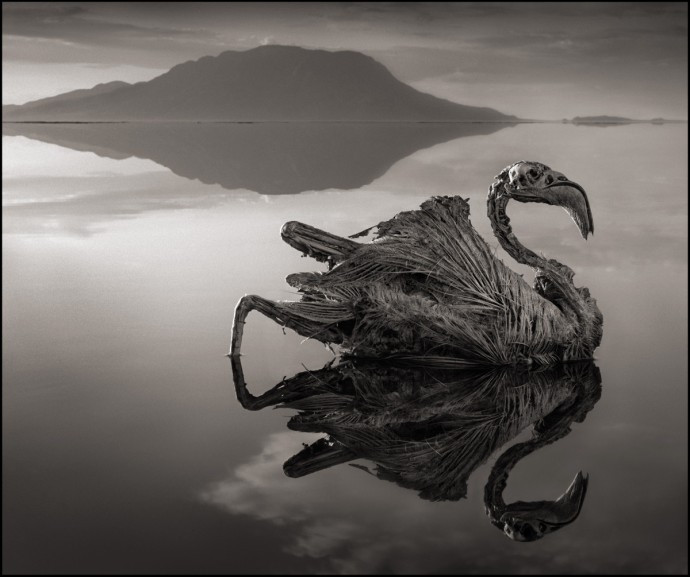

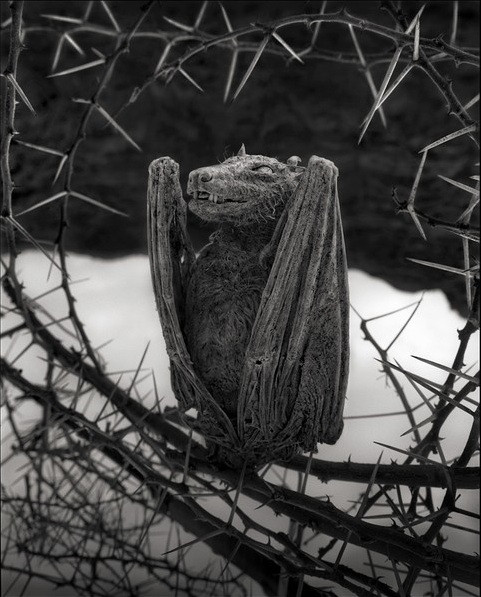
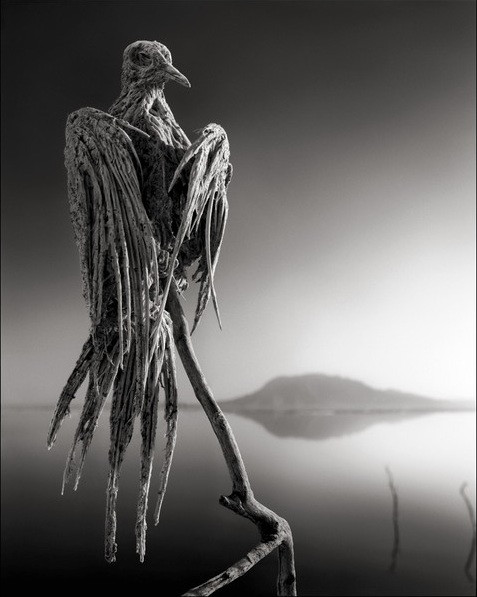
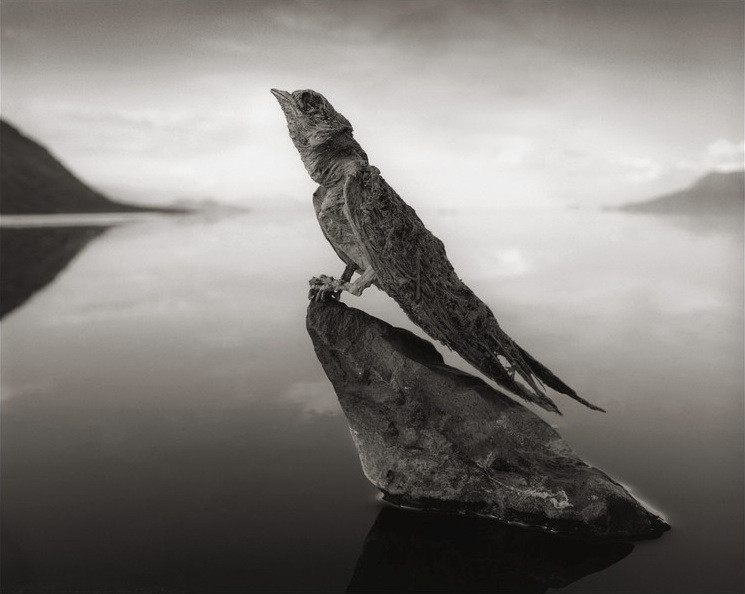
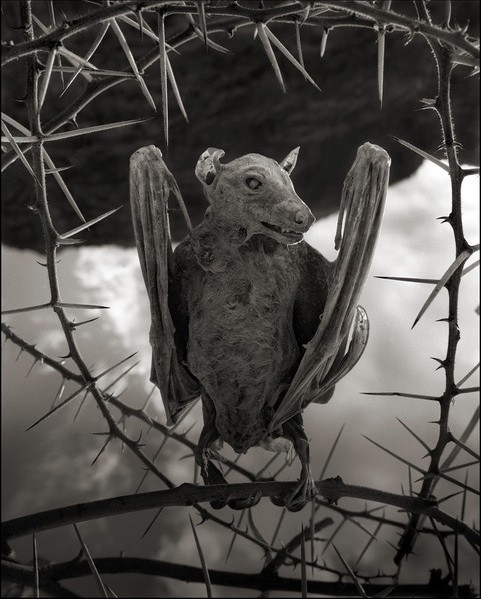
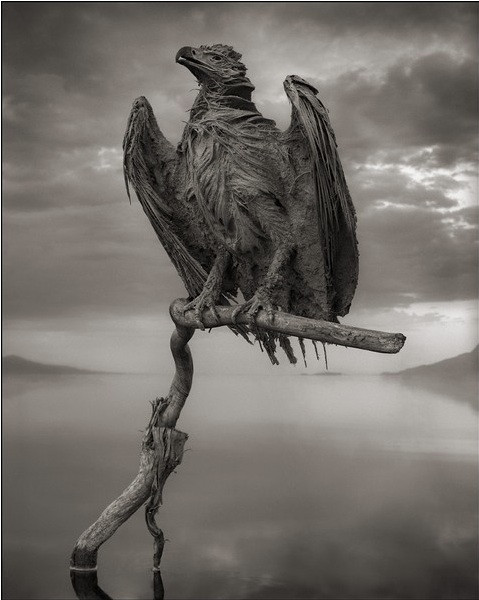
I wonder if any animals around there have developed traits over time specifically to avoid, or survive contact with, this lake. Creepy and cool.
Good question, but since the death of creatures and mummification of them in this kind of “concrete” seems to be the result of falling in the water, I suspect the answer is no. I found this at an additional source now cited in the post:
“So, after feasting on spirulina algae from nearby lagoons, the flamingos flock to this barren wasteland. If the water level’s just right, they court on the temporary salt islands and make mud nests from volcanic dust. Even in a good year, some flamingos that make the trip will die. If they fall into the lake, that’s where they’ll stay, encased in salty cement, until Natron decides it’s time to let them go.”
They look charred by volcanic ash but they do look all metal. The Fish Eagle can go for a good album art as well.
I had the perfect band name to go with it added to my vocabulary yesterday too after reading one of my x-ray reports: “Phlebolith.” Metal Archives says no one used it yet, so go for it aspiring death metal bands!
Great name for a band. Not so great on a personal x-ray. Particularly well-suited to a band using one of these photos, since it seems to be a calcification within a vein.
I’ve been assured by my doctor that they are harmless at this point. They do make for some cool metal street cred though. I think phleboliths are going to be the new corpse-paint.
Good to hear they’re not imminently dangerous. Maybe there’s a way you could be injected with something that would make them glow through the skin. 🙂
I want to use the dove as an album cover. Really cool.
The dove would make a fantastic metal album cover, probably the best one for that in my opinion, but all of them would work.
I already said to Ben that Twilight’s Embrace need to use the crow one as our album cover.
You mean the caped dove?
Sorry, no, the songbird one is what I meant.
those are really creepy and beautiful, i bet someone could make some good money selling those
Nick Brandt is trying to make some good money from them. They are included along with more of his photos featuring animals in East Africa in his book “Across the Ravaged Land”, published by Abrams Books:
http://www.nickbrandt.com/Text_page.cfm?pID=2706
Wow… just wow. This is really beautiful. It looks so alien – as it was taken in the far, far future where we as humans finally managed to poison the entire world.
And yes – as said by many other already – this would make for excellent album art!
I think “Far, far, future” is being optimistic.
Reminds me of an image the Oakland band Embers put on a T-shirt and album cover (I believe it was for Wrath). Very awesome indeed.
Here we go.
This is so metal I think it’s deserving of it’s own TMBITM. I could stare at those for hours, so morbidly fascinating
Lakenatron.bandcamp.com
Thats metal